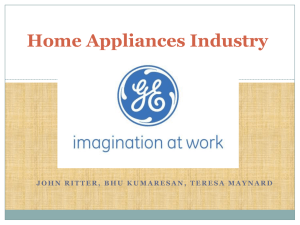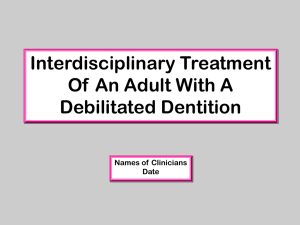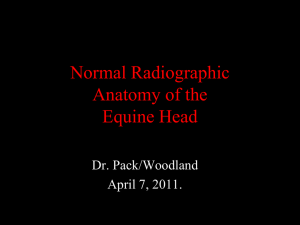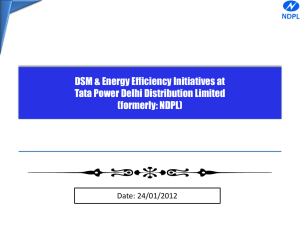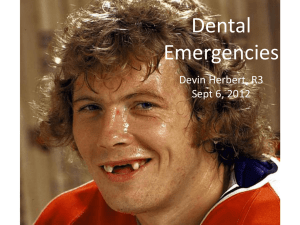矫治器 Appliance
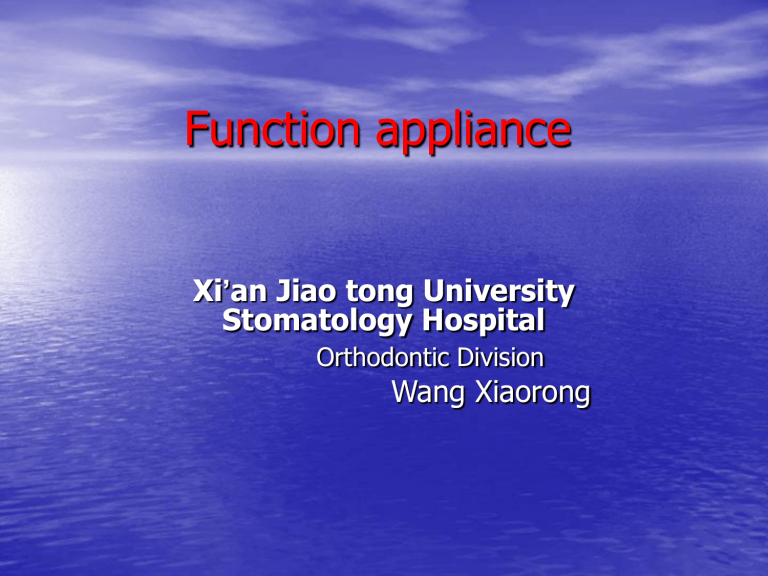
Function appliance
Xi ’ an Jiao tong University
Stomatology Hospital
Orthodontic Division
Wang Xiaorong
1.
The basic concept
• Function appliance : Itself does not produce any mechanical power, its role is changing the orofacial muscle function together to promote development of craniofacial growth, in order to correct the mistake in the formation of malocclusion.
The features of function appliance
• The impact of the use of dental and skeletal muscle
• Upper and lower dentition open bite separation
• Lower jaw forward (or backward) shift
• When swallowing, the lower lip close
• Selective changes in the tooth eruption Road
• Does not affect the eruption of permanent teeth and replacement
The development of function appliance
•
In 1726, the French doctor Fauchard first use expansion.
• 1771 England surgeon Hunten, the first analysis of the mandibular growth
• 1879, the United States, "the father of
Orthodontics" Kingsley, the design of a typical occlusal appliance leaps and bounds, and guide the mandibular forward, established the idea of treatment of mandibular forward.
The development of function appliance
• 1880, published an article, the inclined plane treatment of mandibular retrusion deformities, carried out functional appliance precedent.
• 1908-1936, Denmark and Germany Haupl of Andresen long-term cooperation and invented activator system
• 1951, Stockfisch designed Kinetor appliance.
Functional appliance with the expansion of the combination of helical spring. Function of the maxillofacial region had a significant impact on orthopedics.
The development of function appliance
• Balters designed Biology regulator in 1960.
• Frankel has designed functional regulator in 1967.
• In late 80's our country are carrying out the functional orthopedic treatment.
Principle of Functional appliance
• To the mouth and maxillofacial muscle function to stimulate and guide the bone growth of periodontal ligament receptors in biological regulation, mobilization of the growth potential, to achieve the purpose of correction.
Principle of Functional appliance
• Correction does not in itself have any power, but perioral muscle contractile force, passing through the appliance to the temporomandibular joint, jaw, teeth, bone and other parts, so that deformities have been corrected
Principle of Functional appliance
• Recoverable through the appliance and lip cheek genioglossus muscle coordination between the power to make happen and maxillofacial soft tissue reconstruction, the re-establishment of function and form a balance between the power to the treatment of dentofacial deformity prevention purposes.
Muscle Change
• Treatment, change the tone of facial muscles on the teeth and bones by the application of force size, direction and time, so I noodle region neuromuscular jaw environment is conducive to development and craniofacial growth.
• When caused by swallowing mandibular muscle contraction contribute to the establishment of normal swallowing tooth contact.
Muscle Change
• Appliance because of retention in the mouth lax, swallowing must rely on the tongue to maintain its position, the location of the tongue back to normal
• Emphasize the treatment of lip closure, lip changed the location and activity
• Is a muscle training device.
Change of teeth and alveolar
• Selectively control the vertical height of the teeth
• Inhibit anterior, promote eruption of posterior teeth, to correct deep overbite
Change of teeth and alveolar
• Inhibition of posterior teeth, promoting tooth eruption before the correction of anterior open together.
• Vertical eruption of the teeth at the same time, you can guide them in the near distal direction, to do a small amount of buccolingual movement.
Indication
• Before peak period of growth and development (for the early permanent dentition )
• Upper and lower jaw development is not transferred
• Functional types of malocclusion
Contraindication
• Crowding, misplaced teeth, extraction cases
• Uncooperative patients
The advantages of functional appliance
• The unity of form and function, treatment stability and time is short
• Exert the body growth and development potential and development of the forces of nature
• With fixed appliance used in conjunction, can simplify the second phase of treatment, to a certain extent to avoid extract teeth and orthognathic surgery, so that a more stable therapeutic effects
Treatment procedures
• Diagnosis
• Design
• Occlusal reconstruction
• Craft Room production
Clinical treatment
•
Try to wear
• Treatment period
• Holding period
• Post-treatment
2. Categories
• easy : oblique derivative, lip block, vestibular shield
• Activator Class : Activator 、 Twin-block 、
Bionator 、 Herbst .
• Frankel appliance
Commonly used functional appliance
• oblique derivative, lip block, vestibular shield
• Activator
• Frankel II III
Activator
Design by Andresen..
Advance the mandible several millimeters for
Class Ⅱ correction.
Indication
Growth and development of children
Class Ⅱ bone (mandibular retrusion, mild maxillary protrusion)
Patients with good cooperative
Appliance structure and production
• Maxillary component
Plastic part :
baseplate
Metal parts: Transverse palatal bar
labial bow
• Mandibular component
One whole side of the tongue base, enveloping the anterior labial to 2-3mm
baseplate
The original functional appliance design was a block of plastic covering the teeth of both arches and the palate.
Wax Record Hop
The amount of mandibular advancement
overjet < 6mm
,
guide to cut to cut overjet > 6mm
,
guide in several times
• Open vertical volume
Interest only on the basis of combined space and continue to open 3 - 5mm
• On the mandibular midline to be consistent
Wear appliance
• Wear appliance every day of not less than
12 - 14 hours in rest time and evening
8 - 10-month active treatment period
Maintain one and a half years
activator
• Angle II 1 Classification (wearing appliance into) lower jaw forward and downward (muscles by stretch and fatigue) muscle reflex to pull back in situ mandibular (upper and lower body because of this backward force on inhibition of maxillary dental arch forward development) overlapped anterior occlusal normal
Role and the principle
Mandibular protrusion
Tatsu neutral relations of posterior teeth
Front teeth overjet the normal occlusal
Referral should pay attention to
• Inspect influention second molar eruption and primary and permanent teeth to replace the plastic part
• Whether or not to loose bow lips
• Tooth surface and plastic noodle mediated the relationship between the buffer
• Check active mandibular protrusion case
the function of Activator
• Improvement Class II molar relationship
•
Reduce overbite and overjet.
• To improve the noodle type II category
•
Backward upper anterior
•
Forward under anterior
• Mandibular rotation after
function regulator , FR
• It was designed by German R. Frankel in
60's the 20th century, so is also known as the Frankel appliance.
principle
• FR a major role at the oral part of the vestibular area
• Used appliance retain lip, cheek screen blocked lips, cheek muscle, so that the developing dentition avoid abnormal perioral muscle function
principle
• So that the dental arch, mandible length, width and height on three bearings to maximize development
• Lip shield, buccal vestibular sulcus screen can pull Department periosteum to stimulate the growth of the Department of alveolar bone
FR I
• The appliance is utilized to promote transverse arch development both dentally and skeletally.this is accomplished by the vestibular shields removing external muscle pressure from both the maxillary and mandibular arches.Its also effective for interruption of abnormal mentalis function and promote facial development.
FR II
• The FR II will also accomplish transverse and vertical development of both the maxillary and mandibular arches.
FR III
• This appliance is used to aid in the correction of Class III malocclusions. This can be achieved by retarding further development of the mandible while simultaneously allowing for the development of the maxilla to its fullest growth potential.
FR IV
• This appliance is used exclusively in Class I malocclusions where skeletal open bite,arch width deficiency,or abnormal muscle function are present.
FR V
• It is a modification of the FR
II and as such is intended for
Class II malocclusion,particularly in cases where an increase in vertical dimension is undesirable.It is often used in conjunction with extraoral traction devices.
FR Ⅲ
Indication
Functional Class Ⅲ is caused by such factors as muscular disorders, bad habits, tongue, or interference.
Mild skeletal class Ⅲ , maxillary hypoplasia, normal or mild mandibular protrusion, mandibular incisor to retreat to on the edge, with a favorable growth pattern, no obvious genetic history.
Bionator
Indication
Mixed dentition Class Ⅱ Division 1, maxillary development of normal, functional mandibular retrusion, position on, the development of normal or mildly inadequate Noodles 1 / 3 short or normal mandibular advancement significantly improved after the type
twin block
•
It is plastic
• Upper and lower occlusal contact pad combined into a 45
'angle
• All mattress covers on the second molars and premolars together noodle, and in the second premolar in the near edge of ridge formed in the inclined plane to the near, inclined plane and combined into a 45
'angle
• All coverage under the pad surface premolar area together in the second premolar distal marginal ridge formed in the far 45 'of slope
• All pads in the upper and lower second premolar area 45 'slope of the relationship between occlusal contacts and keep guide to the mandibular protrusion at the location.
Forsus
Forsus appliance is a fixed appliance and common use, rapid correction of malocclusion Angle Ⅱ combined functional appliance. It can be seen as a Herbst appliance and the Jasper Jumper appliance improvements, can produce sustained, light elastic, so that the mandibular oral function in a different state at the protrusion, and mandibular growth stimulation.
Indication
1 ) Functional and early bone malocclusion
2 ) Angle Ⅱ - maxillary protrusion and normal or mildly, moderately incisor on the lip following dump
3 ) Angle III - mandibular who can back on the edge.
extraoral anchorage appliances
• To oral external head, pillow, neck, places, submental extraoral structures such as the anti-base
• Orthodontic tooth movement for threedimensional movement on the mandibular inhibit or promote the growth and development, to change the direction of bone growth to provide sufficient anchorage capacity
Categories
• Rear traction
• Vertical Traction
• Front traction
Rear traction appliance
• Backward force used to make teeth move or inhibit distal alveolar, mandibular forward growth of extraoral anchorage appliance device
• Mainly include the face-bow, J-hook headgear
reverseheadgear
To the amount of pads, chin pocket as composite parts Anchorage
Traction stent as a mask to connect components
Activity or as a fixed appliance within the mouth piece
extraoralverticalpull
• Application of vertical traction to curb dental, alveolar and mandibular vertical growth direction and growth of extraoral anchorage appliance-type devices
Extraoral traction type
• orthodonticforce: Are using face-bow mobile teeth, and power range is 340 ~
450g
• orthopedicforce: Are mobile throughout the dental arch, and even maxillary or mandibular, maxillary on each side 800-
1lOOg, lower jaw on each side 1200-
1700g
Traction power size and time
• reinforcement fmolaranchorage:
Traction on each side 200-300g, can be every day with 8 hours, 10 hours or 12 hours.
• molardistalization
300 ~ 500g traction on each side, no less than 12 hours every day.
Traction power size and time
• Canine rpremolar distalization
• Each side of the 150-300g. Not less than
12 hours every day.
• Intrusionandenmasseretraction fupperanteriors
Each side of the 100-150g, not less than
12 hours every day.
• Inhibition of forward maxillary growth:
500 ~ 800g per side
• Stimulate maxillary growth :500-1000g, not less than 12 hours every day
• Inhibition of mandibular growth: on each side 500g, not less than 12 hours every day
• Perpendicular to the growth inhibition: a single molar down when each side of the
150-300g, down posterior teeth paragraph ,300-500g
Commonly used extraoral anchorage appliance
•
Protraction appliance
•
Outer bow appliance
(
1
)
Protraction appliance
• Indication : Shown deciduous, mixed dentition maxillary hypoplasia caused by anterior teeth / all teeth cross bite.
Protraction appliance
• Composition
Facial device
The amount of board
Chin pocket
Metal stent
Intraoral devices baseplate
Protraction appliance
• Clinical Application
• Intraoral devices: 24 hours / day wear, removed when brushing their teeth
• Extraoral devices: 10 ~ 12 hours / day, strength 300 ~ 500 g / side
Function
• Stimulate the growth of maxillary forward
• Inhibit the growth of the mandibular
• Change the direction of mandibular growth
Protraction appliance
• Other : If the solid potentiometer, to be used in adhesive-type, base adhesive on the teeth. If the maxillary arch narrow, can be expansion, and then traction.
(
2
)
Outer bow appliance
• 1 ) Indications : Excessive maxillary development, up near molar displacement, maximum anchorage
2 ) Frame :
• Intraoral devices: on the first molar band.
Extraoral devices: Headgear high, medium and low face-bow: bow inside and outside the 10 ~
30 degree angle
Outer bow appliance
• Device composed of
• head: headgear or neck strap.
• Face device: face-bow
• Rubber band
Outer bow appliance
• 3 ) Clinical Application :
Headgear : In accordance with the requirements of different locations (high, medium and low)
Face-bow: long, medium and short.
Traction: tooth movement or increase the anchorage 150 grams / lateral maxillary development restrictions on 300 ~ 500 g / side
Outer bow appliance
4 ) function : Pushed to the distal molar movement; restrictions maxillary developmental; increase anchorage traction in the front (in the maxillary extraoral arch welding on Hook, led by the lower jaw forward)
J-hook headgear
• To neck strap or headgear as anchorage components, J-shaped hook connected components as the rear traction device
• Mechanism: J-shaped hook traction device
SHI main arch at the front to move far from canine, premolar or incisor adduction
summary
• Functional appliance power source is the correction of facial muscle strength, by changing the mouth facial muscle function together to promote development and growth and the correction of malocclusion.
• Extraoral anchorage appliance is characterized by greater access to
Anchorage, at the same time, the application of orthopedic force to correct mild deformity of the mandible
